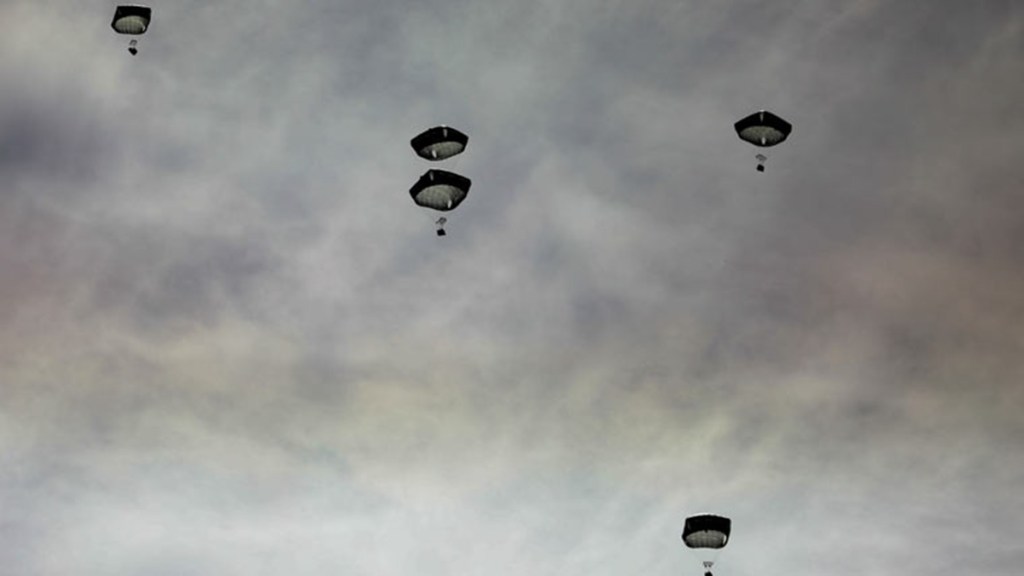US military C-130 cargo planes initiated emergency humanitarian assistance in Gaza on Saturday following a deadly confrontation between Israeli troops and Palestinians who were attempting to get aid. US President Joe Biden authorized the operation after over 100 Palestinians were killed while trying to obtain goods from an aid convoy.
Air dropping humanitarian aid in Gaza: How was the mission executed?
At 8:30 a.m. EST (3:30 p.m. local time), three planes from Air Forces Central conducted the mission, dropping 66 bundles comprising approximately 38,000 meals over southwest Gaza, specifically along the territory’s Mediterranean coast. This airdrop operation was synchronized with the Royal Jordanian Air Force, which had also executed two food airdrops earlier in northern Gaza and has conducted several similar missions in recent months.
The US airdrop is anticipated to mark the beginning of a series of such missions. According to three Biden administration officials, the planes dispersed military Meals Ready to Eat, which are packaged shelf-stable meals containing a day’s worth of calories, in locations deemed safest for civilians to access aid. Following the drop, US authorities monitored the sites and observed civilians retrieving and distributing the food among themselves. These details were disclosed by the officials anonymously to offer additional insights not previously disclosed.
On Friday, Biden announced the commencement of food airdrops to assist starving Gazans, following a tragic incident where over 115 Palestinians were killed and hundreds more wounded during a scramble for aid on Thursday. The Health Ministry in Hamas-ruled Gaza reported the casualties, stating that the victims were among hundreds of people who had rushed towards approximately 30 trucks delivering aid to the north. Palestinians alleged that Israeli troops fired into the crowds, while Israel claimed they had fired warning shots and attributed many deaths to stampedes.
Israel asserted that they discharged warning shots towards the crowd and maintained that many of the casualties were due to trampling.
White House national security spokesperson John Kirby stated on Friday that the airdrops were strategically planned to provide emergency humanitarian assistance to people on the ground in a secure manner. While the United States believes that the airdrops will contribute to alleviating the dire situation in Gaza, they do not view them as a substitute for trucks, which have a greater capacity for transporting aid more efficiently. However, Thursday’s events also highlighted the risks associated with ground transport.
Kirby emphasized that the advantage of airdrops lies in the ability of planes to swiftly deliver aid to specific locations. Nevertheless, in terms of quantity, airdrops will serve as a supplementary method rather than a replacement for ground transportation.
C-130 aircraft: Why is it significant?
The C-130 aircraft is extensively employed for delivering aid to remote regions due to its capability to operate in challenging environments. With a capacity to airlift up to 42,000 pounds of cargo, the C-130 is adept at transporting various supplies, including vehicles, in austere conditions. Its crews are skilled in securing cargo onto large pallets, which are then safely dropped from the aircraft’s rear.
The versatility of these aircrafts has been demonstrated through their involvement in humanitarian missions in Afghanistan, Iraq, Haiti, and other locations.
Since the onset of the war on October 7th, Israel has imposed restrictions on the entry of essential items such as food, water, and medicine into Gaza, with only a minimal amount of aid allowed through the Rafah crossing from Egypt and Israel’s Kerem Shalom crossing. According to the United Nations, a quarter of Gaza’s 2.3 million inhabitants are at risk of starvation due to these limitations. While aid officials acknowledge that airdrops are not the most efficient method of distributing aid, they are viewed as a last resort measure.
(With AP Inputs)

